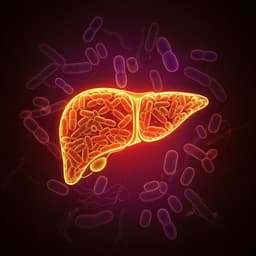
Medicine and Health
Adipocyte death triggers a pro-inflammatory response and induces metabolic activation of resident macrophages
A. Lindhorst, N. Raulien, et al.
This groundbreaking study by Andreas Lindhorst, Nora Raulien, and colleagues explores the formation of crown-like structures in adipose tissue and reveals how adipocyte death sparks a pro-inflammatory response in macrophages. Discover the metabolic activation and changes in lipid metabolism that may link obesity to inflammation.
~3 min • Beginner • English
Introduction
The study investigates how adipocyte death initiates crown-like structure (CLS) formation and alters the activation state of resident adipose tissue macrophages (ATMs). Context: Obesity-associated adipose tissue (AT) dysfunction features adipocyte hypertrophy, immune cell infiltration, and pro-inflammatory cytokine expression. ATMs shift from an M2-polarized state in lean conditions to a pro-inflammatory phenotype with obesity. Recent work suggests obesity induces a distinct metabolically activated phenotype in ATMs rather than classical M1 activation. Purpose: To define the dynamics and causality between adipocyte death and CLS formation, characterize early ATM responses, and determine whether monocyte recruitment is required. Importance: Establishing adipocyte death as a driver of local inflammation and metabolic activation of ATMs would link adipocyte hypertrophy and turnover to chronic AT inflammation in obesity.
Literature Review
Background literature highlights: (1) Obesity-related AT inflammation increases ATMs and shifts polarization toward pro-inflammatory states (Lumeng et al., Weisberg et al.). (2) Obesity induces a metabolically activated ATM phenotype with enhanced lysosomal biogenesis and lipid metabolism distinct from classic M1 (Xu et al., Kratz et al.). (3) Within CLS, ATMs digest dead adipocytes via lysosomal exocytosis, forming lipid-laden foam cells (Haka et al.). (4) Pro-inflammatory cytokines (IL-1β, TNF) increase with metabolically activated ATMs (Kratz et al., Coats et al.). (5) CLS abundance correlates with AT inflammation, with debated origins of CLS ATMs (resident vs. monocyte-derived). (6) Adipocyte turnover is elevated in obesity, but in vivo adipocyte degradation mechanisms were poorly understood. This study addresses gaps on the dynamics, size constraints of efferocytosis, and the origin/phenotype of CLS-associated ATMs.
Methodology
- Animals and diets: Mice housed SPF, chow or high-fat diet (HFD). Reporter strains: Csflr-eGFP (MacGreen) to visualize ATMs; crossed with AdipoqCreERT2:Rosa26-tdTomato flox/flox to label adipocytes (tamoxifen-independent tdTomato expression used). Ethics approved in Leipzig, Germany.
- Adipose explant culture: Epididymal white adipose tissue (EWAT) dissected, cut to <1 mm³, cultured in RPMI with 10% FBS, insulin-transferrin-selenium, antibiotics, immobilized under inserts, 37°C, 5% CO2.
- Live imaging of lipid handling and CLS: AT explants from HFD-fed MacGreen mice stained with BODIPY 558/568 C12. Time-lapse confocal imaging over multiple days. Classified 188 ATM–lipid events (from 40 movies; 6 experiments) as efferocytosis, fragmentation, or CLS formation. Measured lipid droplet diameters before events. Compared living adipocyte lipid droplet sizes in chow vs HFD explants.
- Laser injury model (targeted adipocyte death): In chow-fed explants (no pre-existing inflammation), single adipocytes were irradiated at presumed nucleus using multiple laser lines at 100% for 45 s (Olympus confocal FV300, 20x objective, 10x zoom). Z-stacks collected hourly for ~80 h. Quantified CLS by GFP+ area above threshold within ROI over time using Fiji. Repeated across N=5 experiments; also examined in HFD explants.
- Cell death characterization: Annexin V (iFluor 647) to detect phosphatidylserine externalization and DAPI exclusion 24 h post-injury to infer apoptosis-like early death with intact membranes.
- Whole-mount immunostaining: Fixed explants and fresh EWAT pieces; blocked and stained overnight with pre-labeled antibodies (CD9, CD36, CD38, CD11c, CD64, CD86, CD274, F4/80, TREM2, CD301, CD206). Mounted and imaged by confocal microscopy. Also stained in vivo-formed CLS in lean mice.
- BMDM phagocytosis assay: Bone marrow–derived macrophages differentiated with M-CSF; incubated 48 h with IgG-opsonized BODIPY beads (10, 20, 45 µm). Phagocytosis quantified by flow cytometry (SSC and BODIPY signal) and confocal imaging to verify engulfment.
- Small lipid efferocytosis and CD11c staining: Explants (chow and HFD) cultured with BODIPY; fixed and stained with CD11c to assess induction by small lipid uptake.
- Cell sorting and RNA-seq: 48 h post laser injury, explants digested; GFP+ live ATMs sorted into CD11chigh and CD11clow groups (~10,000 cells/sample) via FACS (BD FACSAria). RNA-seq (CEL-Seq2), analyzed with DESeq2; KEGG pathway enrichment.
- Parabiosis: WT paired with Acta1GFP/+ mice for 2 or 12 weeks. Blood chimerism verified (~45% GFP+/CD45+ in WT partner). Whole-mount AT staining for ATM markers (F4/80, CD11c, CD86) and GFP chimerism within CLS and interstitial ATMs.
- Statistics: Mean ± SEM; normality tested; Student’s t-test or Mann–Whitney U-test; p<0.05 significant.
Key Findings
- Size threshold for efferocytosis:
- In living AT explants, lipid droplet diameter determined the handling outcome: classic efferocytosis by single ATMs for small droplets, fragmentation for medium-sized, and CLS formation for large droplets.
- Critical threshold for classic efferocytosis was ~25 µm diameter (quantified across 188 events from 40 movies in 6 experiments).
- BMDMs phagocytosed beads up to 20 µm efficiently; 45 µm beads were rarely phagocytosed (in vitro corroboration).
- Adipocyte lipid droplet size distribution:
- Chow-fed mice: mean ~50 µm diameter.
- HFD (20 weeks): mean ~100 µm; some approaching 200 µm. Almost no adipocyte-associated droplets <25 µm in either condition, implying dead adipocytes leave remnants above efferocytosis threshold.
- Kinetics and frequency of CLS after targeted death:
- Laser injury of single adipocytes in chow explants induced CLS around ~60% of targeted adipocytes (N=5; significant vs control).
- CLS-associated GFP signal (ATM accumulation) began ~10 h post-injury, plateaued by ~60 h; similar frequency and timing in chow vs HFD explants.
- For large droplets forming CLS, no detectable size decrease >100 h after initial ATM contact; classic efferocytosis cleared droplets within ~36 h; fragmentation took several days.
- Cell death features:
- 24 h post-injury: Annexin V-positive (phosphatidylserine externalization) with DAPI exclusion in depleted adipocytes, indicating apoptosis-like early stages with intact membranes.
- Local ATM activation phenotype in CLS:
- Induced CLS (ex vivo) and physiological CLS (in vivo, lean mice) showed ATMs with high M1-associated markers CD11c, CD86, CD9; surrounding interstitial ATMs were negative.
- Interstitial ATMs were positive for M2 markers CD206 and CD301, whereas CLS ATMs were negative.
- CD64 expressed in both populations; TREM2 not distinctly elevated in CLS ATMs and more prominent in interstitial ATMs in vivo.
- High CD11c expression was not induced by palmitate treatment or small-droplet efferocytosis, indicating specificity to large-particle handling/CLS context.
- Transcriptional programs (RNA-seq, 48 h post-injury, CD11chigh vs CD11clow ATMs):
- Upregulated pathways: antigen processing/presentation, oxidative phosphorylation, lysosome; decreased cell cycle genes in CD11chigh.
- Increased expression of M1-associated genes and reduced M2-associated genes in CD11chigh.
- Elevated genes related to metabolic activation and lipid metabolism (e.g., Cybb/NOX2, lipid transport/metabolism genes) and differential chemokines/receptors, suggesting regulated intra-tissue chemotaxis.
- Protein validation: CLS ATMs expressed CD36 (metabolic activation) and Lamp1/Lamp2 (lysosomal pathway). Early induced CLS lacked CD38 and CD274, whereas in vivo (presumably older) CLS were positive, suggesting time-dependent acquisition of pro-inflammatory markers.
- Origin of CLS ATMs (parabiosis):
- Despite ~45% blood chimerism, very few ATMs in WT partners were GFP+ at 2 weeks, rising to ~20% by 12 weeks, indicating long-lived/resident maintenance.
- In naturally occurring CLS in lean parabiotic mice, ~90% of CLS ATMs were GFP-negative, indicating local, resident origin and minimal monocyte recruitment for CLS formation.
Discussion
The findings demonstrate that adipocyte death alone is sufficient to initiate CLS formation and trigger a locally confined activation of resident ATMs with a metabolically activated, pro-inflammatory gene expression profile. A key mechanistic insight is the size constraint on efferocytosis: adipocytes (50–200 µm droplets) exceed the ~25 µm threshold for efficient single-macrophage efferocytosis, leading to prolonged persistence of lipid remnants and secondary necrosis, which promotes local inflammation. This establishes adipocyte size/turnover as a direct driver of CLS and inflammatory activation in AT even under lean, homeostatic conditions. The ATM phenotype within CLS blends metabolic activation (oxidative phosphorylation, lysosomal biogenesis, CD36, Lamp1/2, NOX2) with features of M1 polarization (CD11c, CD86, CD9, M1 genes), while interstitial ATMs retain M2 characteristics (CD206, CD301). The time-dependent acquisition of CD38 and CD274 in in vivo CLS suggests progressive pro-inflammatory maturation. Parabiosis data and ex vivo CLS induction without blood supply show that CLS formation and early ATM activation predominantly involve resident ATMs rather than recruited monocytes, with regulated intra-tissue chemotaxis suggested by differential chemokine expression. Together, the work links adipocyte death and hypertrophy-driven inefficiencies in efferocytosis to chronic AT inflammation seen in obesity.
Conclusion
This study introduces a live-imaging and laser injury model to induce single-adipocyte death and track CLS formation with high temporal resolution. It establishes a ~25 µm efferocytosis size threshold, shows that adipocyte death reliably triggers CLS and locally activates resident ATMs into a metabolically activated, pro-inflammatory state, and demonstrates that monocyte recruitment is not required for CLS formation in lean mice. These results provide direct mechanistic evidence that adipocyte death and size-related inefficiencies in efferocytosis underpin chronic adipose inflammation in obesity. Implications include prioritizing adipocyte-protective strategies to reduce adipocyte death and targeting metabolic activation pathways in CLS ATMs. Future research should delineate the temporal evolution of cytokine profiles in CLS, clarify signals governing intra-tissue ATM chemotaxis, and assess whether similar mechanisms apply across adipose depots and in obese states in vivo.
Limitations
- Experimental models rely heavily on ex vivo AT explants and a laser-induced adipocyte death paradigm; although in vivo CLS analyses were included, laser injury may not fully recapitulate physiological death modalities.
- Cytokine induction (e.g., IL-1β, IL-6, TNFα) was not increased at early time points in induced CLS; later time-course measurements were not presented and remain to be demonstrated.
- Parabiosis and CLS origin analyses were conducted in lean mice; the extent of monocyte recruitment in obese, chronically inflamed AT may differ.
- TREM2 expression was not elevated in CLS ATMs despite reported roles in CLS biology; functional roles were inferred but not directly tested.
- Sample sizes for some measurements were modest (e.g., N=3 for certain comparisons), and findings may need broader validation across sexes, depots, and models.
Related Publications
Explore these studies to deepen your understanding of the subject.







